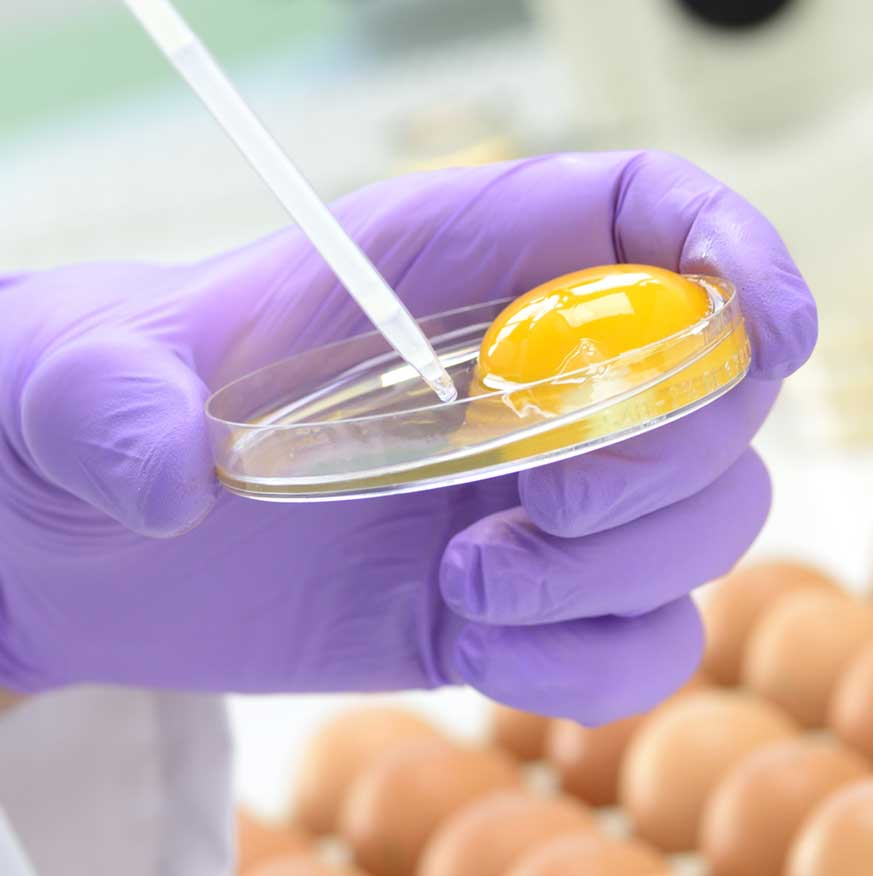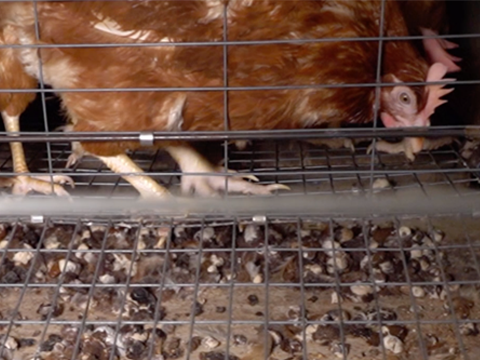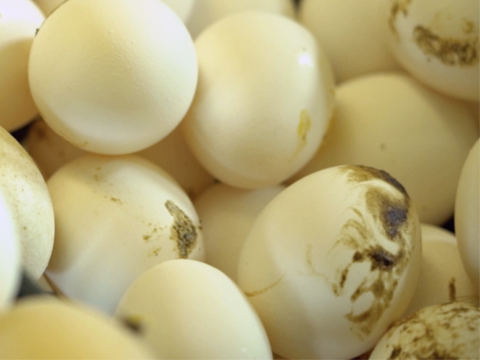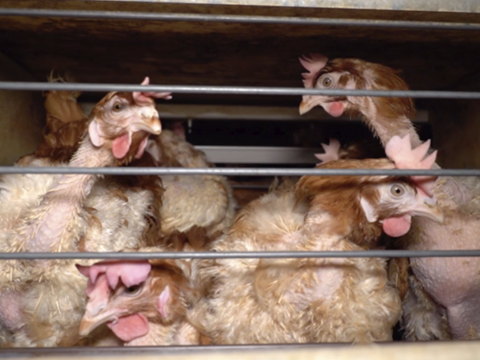
Do you know Dickie Orr?
Dickie Orr, MTY Group’s Board Member, enables animal cruelty in MTY Group’s global egg supply chain
Do you eat at Cold Stone Creamery, Papa Murphy’s, Pinkberry, Wetzel Pretzel, or some other restaurant owned by MTY Group? If so, you may want to think again. A shocking video has revealed what MTY Group, Dickie Orr and other Board members want to keep hidden: the company continues to use eggs from filthy, cruel battery cage egg farms in dishes served to its global customers.
On farms that confine hens in cages, faeces and dirt are caked on the bars of cages where eggs are laid, and faeces piles up just inches away from eggs and from the birds themselves. Mother hens are crammed for nearly their entire lives in cages so small and cruel they are illegal in dozens of countries around the world. The corpses of dead hens are left to decompose right next to hens laying eggs for human consumption.
Most leading restaurant and café brands have already made commitments to use only cage-free eggs globally, including Burger King, Tim Hortons, Papa John’s, Costa Coffee, Dairy Queen, Baskin-Robbins and over 50 other leading food companies, but not MTY Group. It continues to use eggs from filthy, cruel battery cage egg farm in dishes served to its customers.
It’s time for Dickie Orr and MTY Group to stop putting customers’ safety at risk, and stop supporting this severe animal cruelty. It’s time for MTY to catch up with its peers and commit to transitioning to use only cage-free eggs in all its global location. It’s time for MTY Group to go cage-free, globally!
Please sign the petition!
Dickie Orr: I won’t eat at any of MTY Group’s restaurants until you catch up with other leading food companies and commit to stop using eggs from filthy, cruel battery cages. It’s time for MTY Group to go 100% cage-free, globally!

Food Safety Risks Of Caged Eggs
Over a dozen scientific studies have found that caged egg farms have dramatically higher rates of salmonella contamination. The European Food Safety Authority conducted the largest study ever on the issue, analyzing data from five thousand farms. It found that caged egg farms are 25 times more likely to be contaminated with key salmonella strains. (1, 2, 3, 4, 5, 6, 7, 8, 9, 10, 11, 12, 13, 14, 15, 16, 17)
There are numerous reasons why packing hens in cages causes food safety risks. Research by the United States Department of Agriculture shows the stress of cage confinement makes hens more vulnerable to disease. Cages are also hard to clean and disinfect, leading to “a larger volume of contaminated fecal material and dust.” (18, 19, 20, 21, 22, 23)
Caged Eggs Are Cruel
Just like dogs and cats, chickens are smart, intelligent individuals that feel pleasure and pain. Packing an animal for nearly her entire life in a cage so small she can barely turn around is simply wrong. (24)
Battery cages are so cruel they have been banned in dozens of countries around the world. Every mainstream animal protection organization around the world condemns battery cages as cruel and inhumane. (25, 26, 27)
Here is what just a few such organizations have said:

The RSPCA is calling for all cage systems to be banned…and for laying hens to be kept in well-managed alternative systems.
Royal Society for the Prevention of Cruelty to Animals

Intensive farm animal confinement is barbaric and out of line with contemporary values.
American Society for the Prevention of Cruelty to Animals

Hens in cages are more prone to stress and injury, and an increased risk of salmonella.
World Animal Protection
These organisations are not associated with this website。

Battery Cages
MTY Food Group continues to sell customers food containing eggs from suppliers who confine hens in cruel and filthy battery cages

Dirty
At egg suppliers to MTY Group, hens defecate in the same barren cages they lay eggs in

Cruel
Each mother hen spends nearly her entire life packed in a cage so small she can barely turn around
Downloads and Documentation
Equitas is a global non-profit organization based in the United Kingdom that works for consumer protection and animal welfare in food supply chains worldwide.
Citations on the food safety risks and animal cruelty of battery cages:
1: Van Hoorebeke S, Van Immerseel F, Schulz J, et al. 2010. Determination of the within and between flock prevalence and identification of risk factors for Salmonella infections in laying hen flocks housed in conventional and alternative systems. Preventive Veterinary Medicine 94(1-2):94-100.
2: Snow LC, Davies RH, Christiansen KH, et al. 2010. Investigation of risk factors for Salmonella on commercial egg-laying farms in Great Britain, 2004-2005. Veterinary Record 166(19):579-86.
3: 2010. Annual Report on Zoonoses in Denmark 2009. National Food Institute, Technical University of Denmark.
4: Van Hoorebeke S, Van Immerseel F, De Vylder J et al. 2010. The age of production system and previous Salmonella infections on farm are risk factors for low-level Salmonella infections in laying hen flocks. Poultry Science 89:1315-1319.
5: Huneau-Salaün A, Chemaly M, Le Bouquin S, et al. 2009. Risk factors for Salmonella enterica subsp. Enteric contamination in 5 French laying hen flocks at the end of the laying period. Preventative Veterinary Medicine 89:51-8.
6: Green AR, Wesley I, Trampel DW, et al. 2009 Air quality and bird health status in three types of commercial egg layer houses. Journal of Applied Poultry Research 18:605-621.
7: Schulz J, Luecking G, Dewulf J, Hartung J. 2009. Prevalence of Salmonella in German battery cages and alternative housing systems. 14th International congress of the International Society for Animal Hygiene: Sustainable animal husbandry : prevention is better than cure. pp. 699-702. http://www.safehouse-project.eu/vars/fichiers/pub_defaut/Schulz_Salmonella_ISAH%202009.ppt.
8: Namata H, Méroc E, Aerts M, et al. 2008. Salmonella in Belgian laying hens: an identification of risk factors. Preventive Veterinary Medicine 83(3-4):323-36.
9: Mahé A, Bougeard S, Huneau-Salaün A, et al. 2008. Bayesian estimation of flock-level sensitivity of detection of Salmonella spp. Enteritidis and Typhimurium according to the sampling procedure in French laying-hen houses. Preventive Veterinary Medicine 84(1-2):11-26.
10: Pieskus J, et al. 2008. Salmonella incidence in broiler and laying hens with the different housing systems. Journal of Poultry Science 45:227-231.
11: European Food Safety Authority. 2007. Report of the Task Force on Zoonoses Data Collection on the Analysis of the baseline study on the prevalence of Salmonella in holdings of laying hen flocks of Gallus gallus. The EFSA Journal 97. www.efsa.europa.eu/EFSA/efsa_locale-1178620753812_1178620761896.htm.
12: Snow LC, Davies RH, Christiansen KH, et al. 2007. Survey of the prevalence of Salmonella species on commercial laying farms in the United Kingdom. The Veterinary Record 161(14):471-6.
13: Methner U, Diller R, Reiche R, and Böhland K. 2006. [Occurence of salmonellae in laying hens in different housing systems and inferences for control]. Berliner und Münchener tierärztliche Wochenschrift 119(11-12):467-73.
14: Much P, Österreicher E, Lassnig. H. 2007. Results of the EU-wide Baseline Study on the Prevalence of Salmonella spp. in Holdings of Laying Hens in Austria. Archiv für Lebensmittelhygiene 58:225-229.
15: Stepien-Pysniak D. 2010. Occurrence of Gram-negative bacteria in hens’ eggs depending on their source and storage conditions. Polish Journal of Veterinary Sciences 13(3):507-13.
16: Humane Society International, “An HSI Report: Food Safety and Cage Egg Production” (2010). HSI Reports: Farm Animal Protection. 3. http://animalstudiesrepository.org/hsi_reps_fap/3
17: European Food Safety Authority. 2007. Report of the Task Force on Zoonoses Data Collection on the Analysis of the baseline study on the prevalence of Salmonella in holdings of laying hen flocks of Gallus gallus. The EFSA Journal 97. www.efsa.europa.eu/EFSA/efsa_locale-1178620753812_1178620761896.htm
18: The Danish Veterinary and Food Administration. 2004. The national Salmonella control programme for the production of table eggs and broilers 1996-2002. Fødevare Rapport 6, March.
19: Davies R and Breslin M. 2003. Observations on Salmonella contamination of commercial laying farms before and after cleaning and disinfection. The Veterinary Record 152(10):283-7.
20: Methner U, Rabsch W, Reissbrodt R, and Williams PH. 2008. Effect of norepinephrine on colonisation and systemic spread of Salmonella enterica in infected animals: Role of catecholate siderophore precursors and degradation products. International Journal of Medical Microbiology 298(5-6):429-39.
21: Bailey MT, Karaszewski JW, Lubach GR, Coe CL, and Lyte M. 1999. In vivo adaptation of attenuated Salmonella Typhimurium results in increased growth upon exposure to norepinephrine. Physiology and Behavior 67(3):359-64.
22: Shini S, Kaiser P, Shini A, and Bryden WL. 2008. Biological response of chickens (Gallus gallus domesticus) induced by corticosterone and a bacterial endotoxin. Comparative Biochemistry and Physiology. Part B. 149(2):324-33.
23: Rostagno MH. 2009. Can stress in farm animals increase food safety risk? Foodborne Pathogens and Disease 6(7):767-76.
24: Marino, L. 2017. Thinking chickens: a review of cognition, emotion, and behavior in the domestic chicken. Animal Cognition 20(2): 127–147.
25: “European_Union_Council_Directive_1999/74/EC.” Wikipedia: The Free Encyclopedia. Wikimedia Foundation, Inc. Web 03 August 2018, en.wikipedia.org/wiki/European_Union_Council_Directive_1999/74/EC
26: “Farm Animal Confinement Bans.” American Society for the Prevention of Cruelty to Animals. Web. 03 August 2018, www.aspca.org/animal-protection/public-policy/farm-animal-confinement-bans
27: World Organization for Animal Health, “Terrestrial Animal Health Code” (2017). www.rr-africa.oie.int/docspdf/en/Codes/en_csat-vol1.pdf


